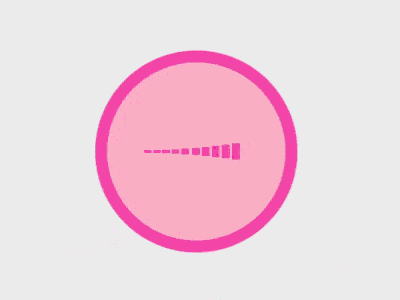
The content of this article is about how to use pure CSS to implement a pulsating loader (source code attached). It has certain reference value. Friends in need can refer to it. I hope it will be helpful to you. help.

https://github.com/comehope/front-end-daily -challenges
Define dom, the container contains 10 sub-elements:
<div> <span></span> <span></span> <span></span> <span></span> <span></span> <span></span> <span></span> <span></span> <span></span> <span></span> </div>
Centered display:
body {
margin: 0;
height: 100vh;
display: flex;
align-items: center;
justify-content: center;
background: linear-gradient(#eee 70%, pink);
}Set the style of the container, which is pink A circle with background and stroke:
.loader {
width: 6em;
height: 6em;
padding: 3em;
font-size: 10px;
background-color: pink;
border-radius: 50%;
border: 0.8em solid hotpink;
}Set the layout mode of the sub-element to horizontal tile:
.loader {
display: flex;
align-items: center;
justify-content: space-between;
}Set the style of the sub-element:
.loader > span {
width: 0.5em;
height: 50%;
background-color: deeppink;
}Add the sub-element’s Animation effect:
.loader > span {
transform: scaleY(0.05) translateX(-0.5em);
animation: span-animate 1.5s infinite ease-in-out;
}
@keyframes span-animate {
0%, 100% {
transform: scaleY(0.05) translateX(-0.5em);
}
15% {
transform: scaleY(1.2) translateX(1em);
}
90%, 100% {
background-color: hotpink;
}
}Set the subscript of the sub-element and let the sub-elements play animation in sequence:
.loader > span {
animation-delay: calc(var(--n) * 0.05s);
}
.loader > span:nth-child(1) { --n: 1; }
.loader > span:nth-child(2) { --n: 2; }
.loader > span:nth-child(3) { --n: 3; }
.loader > span:nth-child(4) { --n: 4; }
.loader > span:nth-child(5) { --n: 5; }
.loader > span:nth-child(6) { --n: 6; }
.loader > span:nth-child(7) { --n: 7; }
.loader > span:nth-child(8) { --n: 8; }
.loader > span:nth-child(9) { --n: 9; }
.loader > span:nth-child(10) { --n: 10; }Add container animation to enhance the pulsating effect:
.loader {
animation: loader-animate 1.5s infinite ease-in-out;
}
@keyframes loader-animate {
45%, 55% {
transform: scale(1.05);
}
}You’re done!
The above is the detailed content of How to use pure CSS to implement a pulsating loader (source code attached). For more information, please follow other related articles on the PHP Chinese website!